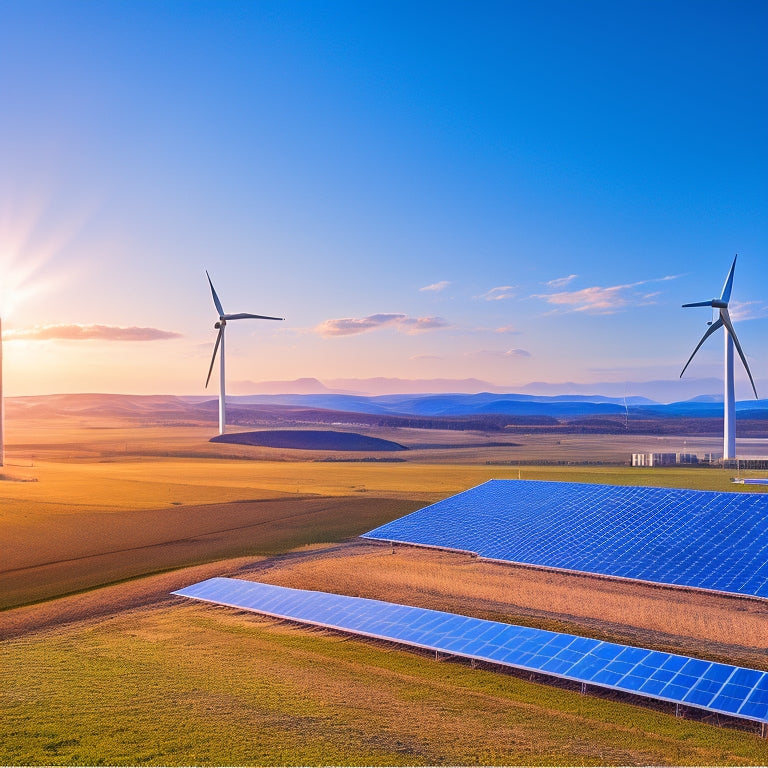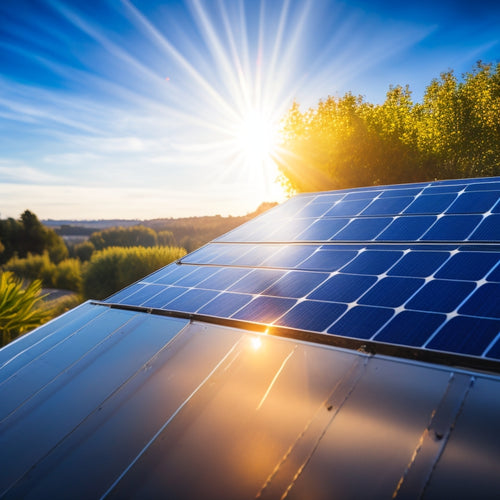
Why Are Energy Storage Systems Important for Renewables
Share
Energy storage systems are critical for maximizing the effectiveness of renewables like solar and wind. They enhance reliability by managing the intermittent nature of these energy sources, ensuring consistent power supply during peak demand. These systems also provide cost-effective energy management, enabling peak shaving and reducing overall energy costs. By storing excess energy, they maintain grid stability and facilitate load balancing, preventing blackouts. Moreover, their durability surpasses traditional batteries, supporting longevity in energy management. Understanding the subtleties of these systems can greatly impact your energy strategy for the future.
At a Glance
- Energy storage systems enhance reliability and consistency in renewable energy supply, addressing the intermittent nature of sources like solar and wind.
- They improve grid stability by balancing supply and demand, preventing blackouts, and providing essential ancillary services.
- Energy storage enables cost-effective energy management through peak shaving and demand response, lowering energy bills and reducing grid stress.
- Selecting the right energy storage technology is crucial for optimizing efficiency, capacity, and scalability to meet energy needs.
- Advanced energy storage solutions offer greater durability and longevity, minimizing maintenance costs and supporting sustainability goals in renewable energy integration.
Sustainable Energy Reliability Boost
To achieve energy supply consistency, you need to integrate advanced energy storage systems that can effectively manage fluctuations in renewable energy generation.
These systems not only enhance grid stability but also guarantee a reliable power supply during peak demand periods.
Energy Supply Consistency
Energy supply consistency is vital for maximizing the potential of renewable energy sources, as it directly impacts grid stability and reliability. During the energy shift, you're likely to encounter fluctuations in generation due to the intermittent nature of sources like solar and wind. This variability can challenge your ability to maintain a steady power supply.
Energy storage systems play an essential role in addressing these challenges, enabling efficient renewable integration. By storing excess energy generated during peak production times, you can guarantee that power is available when demand is high or generation is low. This capability not only enhances the reliability of energy delivery but also enables you to employ renewable resources more effectively.
With consistent energy supply, you can reduce dependency on fossil fuels and minimize greenhouse gas emissions, aligning with your desire for greater autonomy in energy management. Incorporating energy storage solutions into your energy infrastructure allows for a more resilient grid.
As you adopt cleaner energy technologies, energy supply consistency becomes a cornerstone of your strategy, supporting sustainable practices while promoting energy independence.
Grid Stability Enhancement
While renewable energy sources offer significant environmental benefits, they also introduce challenges related to grid stability that must be addressed. As you integrate more renewables into the energy mix, you'll encounter renewable integration challenges, including fluctuations in generation due to variable wind and solar conditions. These fluctuations can destabilize the grid if not managed properly.
This is where energy storage systems come in. By implementing advanced grid resilience strategies, you can enhance grid stability and guarantee a reliable power supply. Energy storage acts as a buffer, absorbing excess energy during peak production times and releasing it during periods of high demand or low generation. This capability not only smooths out the inconsistencies but also supports frequency regulation, which is critical for maintaining grid integrity.
Moreover, energy storage systems can provide ancillary services, such as voltage support and spinning reserves, further reinforcing grid stability.
As you adopt these technologies, you're not only addressing the inherent challenges of renewable energy but also laying the groundwork for a more resilient and sustainable energy future. In doing so, you enable yourself and your community to enjoy the freedom that comes with clean, reliable energy.
Cost-Effective Energy Management
In managing energy costs effectively, you can utilize peak shaving benefits to reduce peak demand charges.
Utilizing high-quality solar battery integration allows for maximum energy distribution and guarantees that excess energy is stored for later use.
Implementing demand response solutions allows you to adjust your energy consumption based on real-time pricing signals, maximizing your overall energy expenditure.
Peak Shaving Benefits
Peak shaving offers a strategic approach to energy management, reducing costs during high-demand periods. By utilizing energy storage systems, you can effectively steer through demand fluctuations and optimize your energy pricing. This proactive management allows you to draw from stored energy during peak times, minimizing reliance on expensive grid power.
Here's a concise representation of the peak shaving benefits:
| Benefit | Description |
|---|---|
| Cost Savings | Lower energy bills by reducing peak demand charges. |
| Grid Stability | Decrease stress on the grid during high demand. |
| Increased Efficiency | Optimize existing energy resources for better performance. |
| Environmental Impact | Lower carbon emissions by using stored renewable energy. |
| Flexibility | Adapt to changing energy pricing and demand patterns. |
Demand Response Solutions
Demand response solutions represent a powerful strategy for optimizing energy consumption and managing costs effectively. By enabling you to adjust your energy usage in response to signals from the grid, demand response helps you enhance your energy flexibility. This approach not only reduces your operational costs but also supports the stability of the overall energy system.
When you participate in demand response programs, you're fundamentally agreeing to modify your energy consumption during peak periods or in response to pricing signals. This proactive engagement allows you to capitalize on lower rates during off-peak hours and helps reduce strain on the grid during high-demand times.
Moreover, demand response solutions can facilitate better integration of renewable energy sources. By aligning your energy usage with the availability of renewable resources, you're contributing to a more sustainable energy ecosystem. This not only aligns with your desire for freedom and autonomy in energy management but also positions you as a responsible energy consumer.
Incorporating demand response into your energy strategy can lead to significant savings while promoting a more resilient and environmentally friendly energy environment.
Accept demand response and reveal the full potential of your energy flexibility.
Key Characteristics Unveiled
In evaluating energy storage systems, you must consider their efficiency and reliability, as these factors directly impact performance. Improved efficiency translates to better energy conversion and reduced losses, while reliability guarantees consistent energy supply during demand fluctuations.
In addition, optimizing energy storage design can help balance capacity and solar array size, leading to cost-effective solutions energy storage cost optimization.
Additionally, these systems play a vital role in enhancing grid stability, making them indispensable for integrating renewable energy sources.
Efficiency and Reliability
When evaluating energy storage systems for renewables, efficiency and reliability emerge as critical characteristics that directly impact performance and integration into the grid.
You need to understand that efficiency measures how well these systems convert and store energy. High-efficiency systems minimize energy loss during the storage process, making them ideal for maximizing renewable output. For instance, thermal storage systems, like molten salt or phase change materials, demonstrate excellent efficiency levels, especially when integrated with solar energy.
Reliability, on the other hand, relates to the system's ability to consistently deliver stored energy when required. Mechanical storage systems, such as pumped hydro or flywheels, offer high reliability due to their sturdy design and rapid response capabilities. When energy demand spikes, these systems can discharge energy swiftly, ensuring that you maintain a stable supply.
In choosing the right storage system, consider both efficiency and reliability. The combination of these characteristics allows for smoother integration of renewables into the grid, making energy access more dependable, flexible, and ultimately, enabling you to utilize the full potential of renewable energy sources.
Grid Stability Enhancement
To enhance grid stability, energy storage systems play an essential role by providing necessary services that balance supply and demand fluctuations. As you maneuver through the energy shift challenges, implementing strong grid resilience strategies becomes essential. Energy storage systems can store excess energy during peak production times and release it during periods of high demand, mitigating the volatility in renewable energy generation.
| Service Type | Functionality | Impact on Grid Stability |
|---|---|---|
| Frequency Regulation | Adjusts output to maintain grid frequency | Reduces risk of blackouts |
| Load Shifting | Moves energy use from peak to off-peak | Balances demand and supply |
| Backup Power | Provides emergency power during outages | Guarantees continuous supply |
With these characteristics, energy storage systems not only enhance grid stability but also strengthen your energy strategy by guaranteeing reliability. As you adopt these technologies, you'll find that they seamlessly integrate into your broader energy structure, addressing the intricacies of modern energy ecosystems. By prioritizing grid stability through energy storage, you can contribute to a more resilient and sustainable energy future.
Selecting Based on Storage Capacity
When selecting an energy storage system, you need to clearly understand your storage capacity requirements based on your renewable energy generation.
Different storage solutions offer varying capacities and efficiencies, making it essential to compare these options against your specific needs.
By evaluating your energy usage patterns, you can choose the most suitable system to optimize performance and reliability.
Furthermore, considering factors such as system sizing and configuration can further enhance your energy management strategy.
Understanding Storage Capacity Needs
Determining the appropriate storage capacity for energy storage systems is vital for maximizing the efficiency of renewable energy sources. You need to assess your energy density requirements, which refers to the amount of energy stored per unit volume or weight. This directly impacts how much energy you can deliver when needed, especially during peak demand periods.
When evaluating storage capacity, consider the scalability potential of your system. Can it easily expand to accommodate future energy needs as you incorporate more renewable sources? A flexible storage solution not only supports current demands but also adapts to changes in energy generation patterns.
Moreover, analyze your energy consumption patterns to identify critical times when energy storage will be most beneficial. Understanding these needs allows you to calculate the necessary capacity to guarantee reliability and efficiency.
Ultimately, by focusing on both energy density and scalability potential, you'll create a strong storage strategy that aligns with your long-term renewable energy goals. This strategic approach enables you to utilize the full benefits of renewable energy, guaranteeing you have the necessary capacity to meet your unique demands without compromise.
Comparing Different Storage Solutions
After evaluating your storage capacity needs, it's important to compare different storage solutions that align with those requirements.
Pumped hydro is often favored for its high capacity and long discharge durations, making it suitable for large-scale energy demands. However, it requires specific geographical conditions.
Thermal storage can provide a reliable solution, particularly in solar applications, by storing heat rather than electricity.
Flywheel technology offers rapid response times and high cycle durability, ideal for applications needing quick bursts of energy.
Compressed air energy storage (CAES) presents another option, using underground caverns to store compressed air, though it has certain efficiency limitations.
Lithium alternatives, such as solid-state batteries, are gaining traction due to their enhanced safety and energy density.
Chemical storage systems also present versatile solutions, capable of storing energy in various forms.
Finally, supercapacitors stand out for their ability to deliver quick energy while maintaining a long lifecycle.
In choosing the right solution, you'll want to reflect on factors like efficiency, cost, scalability, and the specific energy demands of your application.
Each technology brings unique advantages, so select the one that best fits your vision for a sustainable energy future.
Longer Lifespan Than Batteries
When evaluating energy storage systems, consider their durability and reliability compared to traditional batteries.
These systems often feature advanced materials and designs that enhance their lifespan, reducing the frequency of replacements.
Understanding these factors is essential for optimizing your renewable energy investments.
Durability and Reliability Factors
Energy storage systems (ESS) have emerged as an essential component in enhancing the durability and reliability of renewable energy sources. Unlike conventional batteries, ESS are designed with advanced materials that exhibit superior material resilience, allowing them to withstand harsh environmental conditions and prolonged usage.
This resilience directly contributes to their performance longevity, meaning they can operate efficiently over extended periods without significant degradation.
When you integrate ESS into your renewable energy infrastructure, you're investing in a system that minimizes maintenance costs and reduces the frequency of replacements.
This reliability is vital for maximizing your energy output and ensuring a consistent supply, particularly in variable climates. The higher durability of ESS not only supports your energy independence but also aligns with sustainability goals by reducing waste associated with short-lived battery solutions.
Frequently Asked Questions
How Do Energy Storage Systems Impact Grid Stability?
Energy storage systems enhance grid stability by elevating grid resilience, allowing you to manage fluctuations and outages effectively. They guarantee consistent energy access, enabling you to utilize renewable resources without compromising reliability or freedom in energy choices.
What Types of Energy Storage Technologies Are Available?
You've got various energy storage technologies available: battery technologies for quick response, pumped storage for large-scale needs, thermal storage for heat management, flywheel systems for rapid discharge, supercapacitors for high power, and chemical storage for versatility.
Are There Environmental Concerns With Energy Storage Systems?
Yes, there're environmental concerns with energy storage systems. You should consider battery recycling and the life cycle impacts of materials used. Proper management can mitigate these issues, promoting sustainable practices and minimizing ecological harm throughout their use.
How Do Energy Storage Systems Support Electric Vehicle Integration?
You'll find energy storage systems act as silent partners, balancing vehicle charging and optimizing battery management. They guarantee you enjoy seamless electric vehicle integration, enhancing efficiency and reliability while supporting your freedom to choose sustainable transport.
What Role Do Government Policies Play in Energy Storage Adoption?
Government policies shape energy storage adoption by establishing regulatory structures and incentive programs. These measures encourage investment, streamline approvals, and reduce costs, enabling you to integrate advanced storage solutions that enhance energy reliability and independence.
Explore More
In the domain of renewable energy, energy storage systems are vital for reliability and cost efficiency. As the saying goes, "Don't put all your eggs in one basket." By diversifying storage solutions based on capacity and lifespan, you can optimize energy management and guarantee a steady power supply. Embracing these systems not only enhances the performance of renewables but also paves the way for a sustainable energy future, making it imperative for your energy strategy.
Related Posts
-

How Efficient Are Thin Film Solar Cells
Thin film solar cells provide an innovative approach to energy generation, boasting efficiency rates generally betwee...
-

Top Off Grid Solar Batteries for Renewable Energy
When seeking top off-grid solar batteries for renewable energy, consider options with advanced battery chemistry, suc...
-

Off Grid Solar Batteries
As you shift to off-grid living, you'll rely on high-performance solar batteries to store excess energy generated by ...


